Review for Michiko and Hatchin - Part 1 - Limited Edition
Introduction
Michiko & Hatchin is a very memorable anime for me, but mostly for the wrong reasons. Michiko & Hatchin dates from 2008, back when online anime was just really getting started thanks to sites like Crunchyroll, and not every show was getting picked up for streaming. Also, in the hiatus between Samurai Champloo and Kids on the Slope, Michiko & Hatchin was the one anime series to have Shinichiro Watanabe’s name attached to it, although he served as music producer, not director. The show did also have the road movie feel of a show like Bebop or Champloo however. Helming the show was female director Sayo Yamamoto, who would later go on to direct The Woman Called Fujiko Mine, and in 2008, when it seemed that all the noteworthy shows were getting some form of online streaming, Michiko & Hatchin was noticeable by its absence.
The wrong reason, Michiko & Hatchin was actually the last anime I watched by illicit means. I did make a mental note to actually buy the show when it became available on home media, but the shocking thing is, that in an industry where anime can be licensed, localised and on shop shelves in the UK within 18 months of first being broadcast in Japan, it took a show with this kind of pedigree behind it, this kind of quality, nearly five years to be licensed and dubbed, and that only in the US and Australia at this time. You can’t believe how thrilled I was to finally get my hands on a legitimate copy of the show. Actually you can’t believe how thrilled I was to learn that the US release was Region AB for Blu-ray. But now that I have part 1, will the show be as good as it was when I watched those poorly encoded, low-resolution, hideously fan-subbed streams?
For an orphan to have a roof over her head might be considered fortunate, especially in the kind of unnamed Latin American country where Hana Morenos lives, a country where crime and exploitation are rife. Hana at least has a foster family... an abusive mother, two siblings that like to beat on her, and an outwardly pious priest for a father who only shows her any semblance of consideration on the days that the child welfare officer visits with the cheques. It’s such a miserable life that Hana hopes for someone, anyone to rescue her. Maybe she should have been a little more specific with her wish, as when Michiko Malandro arrives, it’s through the window on a whopping great motorcycle. She’s not aiming on sticking around either. She’s just broken out of a high security prison and is on the run from her childhood nemesis Atsuko Jackson and the rest of the police. But she wants to take Hana Morenos, who she quickly dubs Hatchin and together find her former lover, and Hana’s father Hiroshi Morenos. He’s all that the two have in common, that and a tattoo. Cross country, on the run from the police, maybe the two will also be able to bond... if they don’t drive each other crazy first.
Eleven episodes of Michiko & Hatchin are presented in this Blu-ray and DVD combo collection across 2 Blu-ray discs, and 2 DVD discs. The Limited Edition that I bought also comes with a hardboard artbox with room for Part 2 of the series as well. The episodes are distributed across the Blu-rays as follows
Disc 1
1. Farewell, Cruel Paradise!
2. The Brown Sugar Outlaw
3. Like A Frantic Pinball
4. Stray Cat Milky Way
5. The Saudade of Fools, parte 1
6. The Saudade of Fools, parte 2
7. The Rain that Falls in Monotone
8. Black Noise and a Dope Game
Disc 2
9. The Chocolate Girl in Love
10. The Carnival of Hyenas
11. Starting Line Downpour
Picture
Michiko and Hatchin gets a 1.78:1 widescreen transfer at 1080p resolution. It’s a fantastic looking show, rich with detail, colours and style, and directed with assured flair, giving the show the same kind of exploitation vibe that you see in Tarantino movies. It’s a mix of homage and a contemporary approach to directing that really works well. From the moment you see the incredible pop-art opening, you know that this is a show, like its spiritual forebears Bebop and Champloo, where the production values are key. You can see that in the aged and dirty world design, the detailed and evocative character design, and the style oozing from every pore of this show. On the rare occasion, you might see the sign of a budget slipping when a character might slip off model, and there are odd directorial choices, such as a foul mouthed main character’s middle finger being pixellated out. But generally this is one of the better looking shows of the last decade. The Blu-ray transfer does this justice, clear and sharp throughout, the richness of the colour palette coming across, and the animation presented smoothly. There might be a little colour banding to pick nits at, but otherwise this looks very nice indeed.
The images in this review are taken from the DVD component of this release, and don’t reflect the quality of the Blu-ray.
Sound
You have the choice between Dolby TrueHD 5.1 Surround English, and 2.0 Stereo Japanese, with optional translated subtitles and a signs only track. As always my choice was for the original language audio, and I was very happy with the voice actor performances, the stereo separation given to the action sequences and ambience, and the exceptional Latin inspired music soundtrack. As you would expect with Shinichiro Watanabe curating the show’s music, this is an exceptional piece. I gave the dub a try, and was pleasantly surprised with a host of performances from anime voice actors freed from the usual cutesy tropes and clichés of the majority of the medium. Michiko and Hatchin is an adult show, in Japan it was made to appeal to female office workers coming home after a hard day at work looking for some escapism, so this is a show bereft of the character clichés that appeal to the otaku ‘mainstream’ and that’s reflected in the dub. Hatchin is always going to sound older than her years (oddly enough that’s easier to handle in the Japanese than the English), but I was shocked (in a good way) to hear Monica Rial’s performance as Michiko, so unlike the usual roles she gets. There’s also some style and sass from Sametria Ewunes as Atsuko. The subtitles are accurately timed and free of typographical error.
Extras
Four discs are presented in an Amaray style Blu-ray case with a reversible sleeve. There are two hinged panels with one disc either side, two DVDs and two Blu-rays. The Limited Edition also comes with the artbox, which also has space for the part 2 release as well.
The extras on the Blu-rays are presented as follows. The discs boot up to an animated menu screen. Disc 1 autoplays a trailer for The Woman Called Fujiko Mine first, and Disc 2 autoplays a trailer for Last Exile: Fam, The Silver Wing.
The only extras on Disc 1 are audio commentaries.
Episode 1 gets a track from ADR Director Chris Bevins (also the voice of Hiroshi), Monica Rial (Michiko, yes really!) and Jad Saxton (Hana a.k.a. Hatchin). There’s a bit of luvvie-ness to the track, but it comes across as a measured commentary. What also comes across is the performers’ passion for this particular title.
Episode 2’s commentary sees Chris Bevins and Monica Rial joined by Sametria Ewunes (Atsuko Jackson) for another agreeable commentary, which points out some of the influences on the show.
Disc 2 offers a couple of featurettes. Michiko: The Woman Behind it All offers a 15 minute chat with Monica Rial about her character and the show. It’s a little matter of fact and very scripted, and beware of some spoilers for the show.
Unveiling Press Conference lasts 11 minutes and offers interviews with the director Sayo Yamamoto and voice actors Yoko Maki (Michiko), Suzuka Ohgo (Hatchin), and Maki Sakai (Atsuko) as they introduce the show to the world.
You get the Live Action Promo Video, the Anime Promo Videos, and for once, very welcome Textless Credits, and all of these extras are presented in HD.
Also on the second disc are trailers for other Funimation shows, including Eureka Seven AO, Sakura Wars, Blood-C, Is This A Zombie? Of the Dead, One Piece, High School DxD, and Appleseed XIII.
The DVD version of this show presents its content with static menus on two discs with the episodes given a 6-5 split. Audio is Dolby Digital 5.1 and 2.0, while the 1.78:1 anamorphic NTSC image gets a very nice progressive transfer. The difference is apparent in the resolution, and the lower quality of colour reproduction, which doesn’t do this show’s world design justice in the same way as the Blu-ray.
Conclusion
The Latin American country with a heavy dose of Japanese influence that Michiko and Hatchin takes place in is never named in this show, but it isn’t just a pie in the sky culture mash-up, an alternate Brazil. Fun fact, Brazil has the largest population of Japanese in the world outside of Japan, some 1.7 million. The second largest population of Japanese is in Peru. When one of the most controversial leaders of Peru was Alberto Fujimori, then character names like Michiko Malandro, Hiroshi and Hana Morenos, Satoshi Batista, and Atsuko Jackson don’t seem so far-fetched. In terms of depiction of culture and view of the world, Michiko and Hatchin delights in re-creating a Latin American atmosphere.
Michiko and Hatchin can be taken as the third in a trilogy of anime shows inspired by the road movie genre following Cowboy Bebop and Samurai Champloo. All three shows focus on a small cast of central characters, and each story sees them move on to a new location to interact with a different guest cast, and tell a different variety of story, whether it’s drama, comedy, action or romance. The setting is different of course, the future solar system, late Edo era Japan, or in this case, contemporary Latin America, although the exact time frame remains unclear. Certainly Atsuko’s hair indicates a 1970s setting. The big difference is that Michiko and Hatchin is a tale told from a female perspective, not surprising given the director.
This isn’t a show that revels in fan service, although Michiko certainly isn’t a strain on the eyes, and she can work a bra top. This is a show about strong female characters, and more importantly, strong characters that are flawed, imperfect, and have issues that they need to work through. That’s certainly true for Michiko and it’s true for Hatchin as well, and to a lesser extent Atsuko.
At the start of the show, Michiko is in prison, and given her ‘take no crap’ attitude to life it’s easy to see why. She’s still burning a candle for her lover Hiroshi. Everyone thinks he died in a bus bombing, but when Atsuko taunted her with a picture of a child who looks just like him, born two years after the explosion, Michiko becomes convinced that he is still alive. She wants him back and eventually escapes. Her first thought is to find the child and use her to get to Hiroshi. Leaving a wake of mayhem behind her, she winds up rescuing Hana from an abusive foster family, and Hana goes with her because being on the run with an escaped prisoner is better than staying where she is.
And so the search for Hiroshi begins. Michiko’s fixated on him, Hana is just a means to an end, so unsurprisingly they get off on the wrong foot. At the same time, Hana is fiercely independent and refuses to trust Michiko or anyone else, so communication skills are lacking on both sides. Hana has a sense of right and wrong, Michiko believes in taking what she needs, and she’s also capricious, apt to be distracted from her charge. The two wind up arguing more often than not. But as the series progresses they begin to rub off on one another. Michiko’s example begins to give Hana strength and self confidence, while Michiko slowly begins to care about this little girl despite herself. It’s no smooth path though, Hatchin leaves on more than one occasion unable to put up with Michiko’s selfishness, and Michiko even dumps Hatchin at the orphanage where she grew up when the arguments get too much. But by the midpoint of this show, the two get to a point in their relationship that they might just be able to commit to each other, the first inklings of a familial relationship. Of course Michiko might do something stupid again and blow it, or Hana might set her expectations sky high once more and set herself up for disappointment, but they are in a better place than at the start of the story.
Of course there are the individual stories on this particular road trip, although some tales are more ephemeral than others, and happy endings aren’t guaranteed. The first two episodes deal with escapes, Michiko’s escape from prison, and Hatchin’s escape from her circumstances, and how they first get to know each other. The first stop after that is where Michiko starts looking for Hiroshi, and to keep Hatchin happy after her shoes were stolen, steals for her a new pair in return. Hatchin’s guilt about this winds up with her getting a job in a fast food restaurant, while Michiko’s questions about Hiroshi lead her to get involved with a stripper named Pepe Lima and a gang of street kids.
They then travel to the town of Vermelha, where Michiko and Hiroshi used to live, and where Hiroshi ran in a street gang named Monstro with his childhood friend Satoshi Batista. It’s where Michiko got caught up in a gang battle, and was blamed and arrested for the death of a rival gang leader. She’s going back there to look for Satoshi, but Fantasma’s number two learns of Michiko’s return and looks for revenge. He finds Hatchin first.
When Michiko and Hatchin finally get close to finding Satoshi, they get into even more trouble, as it turns out that a petty criminal has been using Satoshi’s name to make a reputation for himself. Michiko finds the wrong Satoshi at the same time as another Monstro gang member does and once again Michiko gets caught in the middle of some dangerous folks. It only gets more dangerous when she really does catch up to Satoshi, at the same time as Atsuko and the rest of the police. Having had enough of all this, Hatchin runs off and joins the circus, a circus which has a sideline in trafficking children.
These are interesting and engaging stories. Michiko and Hatchin isn’t shy about showing the underbelly of Third World Latin America, whether it’s child trafficking, or gang violence. These are slum communities where the only way to escape poverty is through crime, and children start early, even using guns. Michiko and Hatchin doesn’t flinch from showing this seedy side of society. It could be intense and an exciting ride through this series, but the pacing is a little off. The episodes are variable, and in a generally brilliant show, you get the odd sprinkle of mediocrity dragging it down. First there’s an episode where their bike breaks down, and they’re stuck in a rainy stilt village on a river waiting for it to be repaired. It’s an episode where Michiko doesn’t quite have a fling with the husband of a hairdresser, and Hatchin gets mad about this, and then gets madder at some bullies on the river.
The second time this sort of thing happens is in the two part episode where Michiko catches up to Satoshi. That ends on a pretty powerful cliff-hanger, and you expect the next episode to pick up that story. Instead it switches to Hatchin, to show what she was doing in the meantime. She’s making friends with a ten year old circus acrobat named Rita, who’s fending off the advances of a local boy by pretending that Hatchin is her boyfriend, and also dealing with her feelings for the older man who she works in the circus with. That episode pretty much throws a monkey wrench into the tension and suspense that had built up with the Satoshi Batista plot line, and picking it back up in the next episode doesn’t have the required effect.
So Michiko and Hatchin isn’t perfect when it comes to narrative. But there really isn’t another anime like it to my knowledge. The Latin American world that its characters inhabit is rich with culture, style and atmosphere, and the story it tells is likeable and engaging. The somewhat rare thing in an anime is the presence of strong female characters that don’t conform to anime stereotypes. These are complex and interesting characterisations that hold the attention and get you engaged with their inner lives. You become invested in Hatchin and Michiko’s non-relationship as they begin to thaw towards each other, and you want to know more about Michiko and Atsuko’s shared past. It’s a unique show, and for that reason alone it’s worth your attention. That the characters are fun, and the episodes are entertaining for the most part really does it make it worth owning.
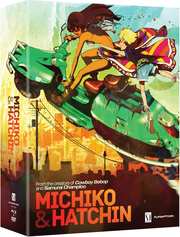



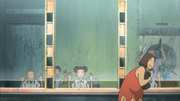


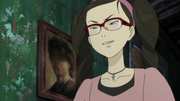
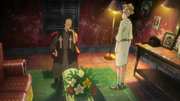
















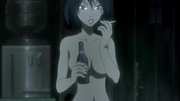





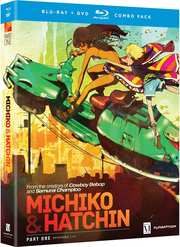

































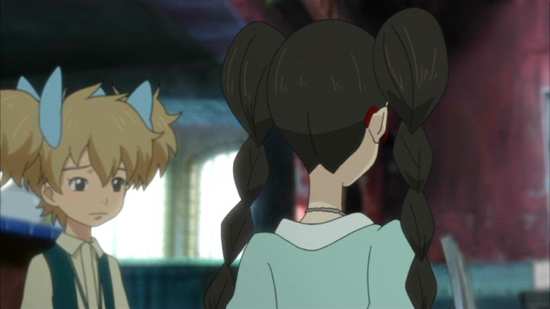



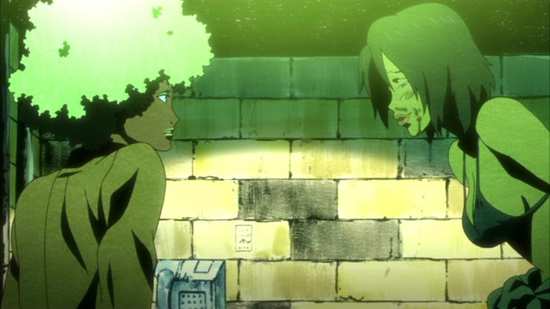

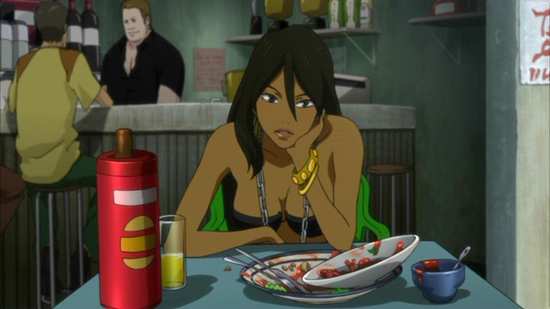

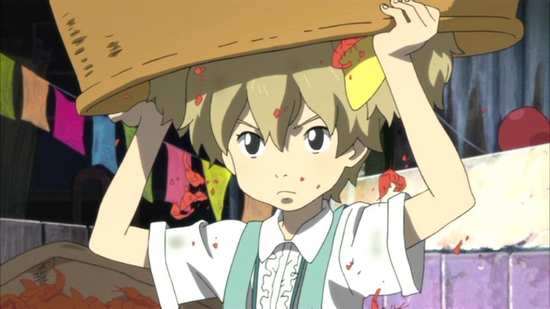









Your Opinions and Comments
Be the first to post a comment!